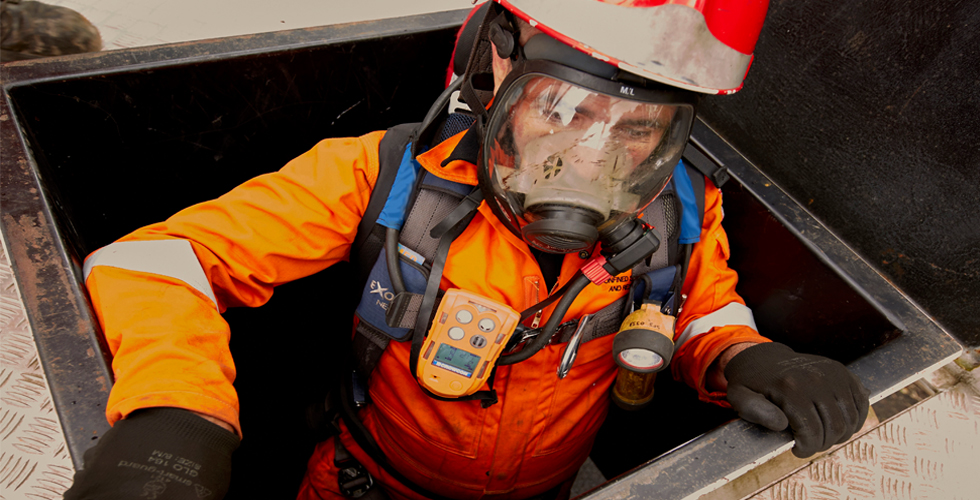Confined Space Entry: General
Accurate identification is an important aspect of making a safe entry into a confined space. Not all confined spaces will be considered permit-required confined spaces and being able to identify the difference between the two is important. To clarify what constitutes a confined space, the following definition will be used.
A confined space is any space that has the following characteristics:
- It is large enough or so configured that an employee can bodily enter and perform assigned work.
- It has limited or restricted means for entry or exit. Openings may be small in size and/or may be difficult to move through easily. In some cases openings may be very large (for example, open-topped spaces such as mud or water tanks).
- It is not designed for continuous employee occupancy.
Once a space has been identified as confined, the hazards that may be present within the confined space must be determined. Some hazards that may be present include the following:
- Oxygen-deficient atmosphere
- Flammable atmosphere
- Toxic atmosphere, such as hydrogen sulfide gas given off from sludge in the bottom of the tank
- Contains a material that has the potential for engulfing an entrant.
- Has an internal configuration such that an entrant could be trapped or asphyxiated by inwardly-converging walls or by a floor that slopes downward and tapers to a smaller cross-section.
- Mechanical or physical hazards such as mud agitators, mud guns or even elevated temperature.
Confined spaces are classified in two categories:
A Non-Permit Confined Space is a confined space that does not contain, nor has the potential to contain, any hazard capable of causing death or serious physical harm.
A Permit-Required Confined Space is a confined space that is potentially hazardous if it contains one of the hazards or characteristics listed above. It contains or has a potential to contain a hazardous atmosphere.
Oxygen-Deficient Atmospheres: The normal atmosphere is composed of approximately 21% oxygen and 79% nitrogen. An atmosphere containing less than 19.5% oxygen shall be considered oxygen-deficient. The oxygen level inside a confined space may be decreased as the result of either consumption or displacement. Oxygen is consumed during combustion of flammable materials, as in welding, cutting, or brazing. Oxygen can also be consumed during chemical reactions such as in the formation of rust on the exposed surfaces of a confined space. The number of people working in a confined space and the amount of physical activity can also influence oxygen consumption. Oxygen levels can also be reduced as the result of oxygen displacement by other gases.
Flammable Atmospheres: Flammable atmospheres are generally the result of flammable gases, vapors, dust mixed in certain concentrations with air, or an oxygen-enriched atmosphere. Oxygen-enriched atmospheres are those atmospheres that contain an oxygen concentration greater than 22%. An oxygen- enriched atmosphere will cause flammable materials such as clothing and hair to burn violently when ignited. Combustible gases or vapors can accumulate within a confined space when there is inadequate ventilation. Gases that are heavier than air will accumulate in the lower levels of a confined space. Therefore, it is especially important that atmospheric tests be conducted near the bottom of all confined spaces. Work such as spray painting, coating, or the use of flammable solvents for cleaning can result in the formation of an explosive atmosphere. Welding or cutting with oxyacetylene equipment can also be the cause of an explosion in a confined space and shall not be allowed without a hot work permit. Oxygen and acetylene hoses may have small leaks in them that could generate an explosive atmosphere and, therefore, should be removed when not in use. The atmosphere should be tested continuously while any hot work is being conducted within the confined space.
Toxic Atmospheres: Toxic atmospheres may be present within a confined space as the result of one or more of the situations described below.
- The product stored in the confined space may give off fumes that can be absorbed by the walls and give off toxic vapors when removed or when cleaning the residual material. The product can also produce toxic vapors that will remain in the atmosphere due to poor ventilation.
- The work being conducted in the confined space can generate toxic atmospheres. Examples of such work include: Welding or brazing with metals capable of producing toxic vapors, painting, abrasive blasting, scraping, sanding, cleaning and/or degreasing with solvents.
Mechanical and Physical Hazards: Problems such as rotating or moving mechanical parts or energy sources can create hazards within a confined space. Unguarded machinery including all rotating or moving equipment such as pumps, process lines, electrical sources, etc., within a confined space must be identified. Physical factors such as fall hazards, steam or chemical lines, electrical hazards, heat which may raise the body temperature above 102°F, cold, noise, vibration, and fatigue can contribute to accidents. Excavations deeper than four feet could present the possibility of engulfment.

